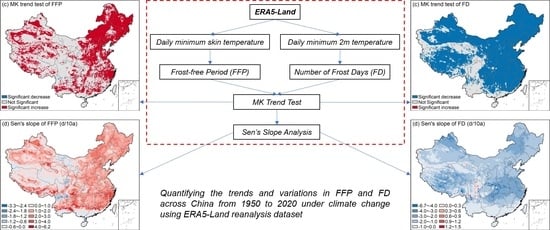Quantifying the Trends and Variations in the Frost-Free Period and the Number of Frost Days across China under Climate Change Using ERA5-Land Reanalysis Dataset
Abstract
:1. Introduction
2. Materials and Methods
2.1. Study Area
2.2. Data Collection
2.2.1. Reanalysis Dataset of ERA5-Land
2.2.2. Dataset for ERA5-Land Evaluation
2.3. Methods
2.3.1. Quantitative Criteria
2.3.2. Data Evaluation
2.3.3. Trend Analysis
3. Results
3.1. Performance of ERA5-Land
3.2. Spatial and Temporal Variation of Annual Mean Minimum Ts and Ta
3.2.1. Annual Mean Minimum Ts
3.2.2. Annual Mean Minimum Ta
3.3. Spatial and Temporal Variation of FFP
3.3.1. Spatial Distribution
3.3.2. Temporal Variations
3.4. Spatial and Temporal Variation of FD
3.4.1. Spatial Distribution
3.4.2. Temporal Variations
3.5. Regional Interannual Trends and Variations in FFP and FD
3.6. Regional Variation Differences in FFP and FD
4. Discussion
4.1. Uncertainty of ERA5-Land on the Quantification of FFP and FD
4.2. Effect of Variations in FFP and FD on Agriculture Production
5. Conclusions
Author Contributions
Funding
Institutional Review Board Statement
Informed Consent Statement
Data Availability Statement
Acknowledgments
Conflicts of Interest
References
- Fan, X.; Wang, Q.; Wang, M. Variations in frost-free period in Shanxi province, China: 1959–2008. Ecol. Environ. Sci. 2010, 19, 2393–2397. [Google Scholar]
- Yu, W.; Yang, Q. Change Laws of Frost-free Period and Its Impact on Agriculture in Linjiang. J. Anhui Agric. Sci. 2012, 40, 8248–8249. [Google Scholar]
- Gao, M.; Jia, H.; Pei, Z.; Yang, X.; Wang, H. The Changing Trends of the First and Last Frost Dates, Frost-free Periods in Recent 58 Years in Linfen City. Chin. Agric. Sci. Bull. 2014, 30, 272–275. [Google Scholar]
- Karl, T.R.; Ghazi, N.A. Clivar/GCOS/WMO Workshop on Indices and Indicators for Climate Extremes Workshop Summary. In Weather and Climate Extremes; Springer: Dordrecht, The Netherlands, 1999. [Google Scholar]
- Peterson, T.; Folland, C.; Gruza, G.; Hogg, W.; Mokssit, A.; Plummer, N. Report on the Activities of the Working Group on Climate Change Detection and Related Rapporteurs 1998–2001; World Meteorological Organization: Geneva, Switzerland, 2001. [Google Scholar]
- Ma, Z. Variation of Frost Days and Its Relationship to Regional Warming in Northern China. Acta Geogr. Sin. 2003, 58, 31–37. [Google Scholar]
- Kong, X.; Feng, C.; Cao, D.; Liu, Y.; Han, X. Analysis on the Changes of the First and Last Frost Date and the Frost-free Period in Linqing City in Recent 30 Years. J. Hebei Agric. Sci. 2014, 18, 97–99, 103. [Google Scholar]
- Erlata, E.; Türke, M. Analysis of observed variability and trends in numbers of frost days in Turkey for the period 1950–2010. Int. J. Climatol. 2012, 32, 1889–1898. [Google Scholar] [CrossRef]
- Gao, H.; Cai, G.; Lu, Y.; Zhang, X. Spatial and temporal variations of frost days in Guizhou province from 1960 to 2013. J. Agric. Sci. 2017, 38, 16–19, 42. [Google Scholar]
- Wang, G.; Xu, Y.; Zhu, Y.; Zhang, H.; Liao, J. The Spatial and Temporal Characteristics and Trend of Frost Days over China for the Past 50 Years. Meteorol. Mon. 2009, 35, 61–67. [Google Scholar]
- Wypych, A.; Ustrnul, Z.; Sulikowska, A.; Chmielewski, F.-M.; Bochenek, B. Spatial and temporal variability of the frost-free season in Central Europe and its circulation background. Int. J. Climatol. 2016, 37, 3340–3352. [Google Scholar] [CrossRef]
- Chervenkov, H.; Slavov, K. Inter-annual variability and trends of the frost-free season characteristics over Central and Southeast Europe in 1950–2019. J. Cent. Eur. Agric. 2022, 23, 154–164. [Google Scholar] [CrossRef]
- IPCC. Climate Change 2021: The Physical Science Basis; IPCC: Geneva, Switzerland, 2021. [Google Scholar]
- Chao, Q.; Yan, Z.; Sun, Y.; Jiang, Z.; Liao, H.; Jia, S.; Cai, R. A recent scientific understanding of climate change in China. China Popul. Resour. Environ. 2020, 30, 1–9. [Google Scholar]
- Li, Y.; Xie, L. Current situation and cause analysis of global climate change. In Proceedings of the 2010 Annual academic Meeting of Chinese Crop Society, Shenyang, China, 13–14 September 2010. [Google Scholar]
- Popov, T.; Gnjato, S.; Trbic, G. Trends in frost days in Bosnia and Herzegovina. Glas. Srp. Geogr. Drus. 2017, 97, 35–55. [Google Scholar] [CrossRef]
- Easterling, D. Recent Changes in Frost Days and the Frost-Free Season in the United States. Bull. Am. Meteorol. Soc. 2002, 83, 1327–1332. [Google Scholar] [CrossRef]
- Xu, F.; Zhang, S.; Wang, Q.; Chang, C.; Qin, Y. First, Last Frost Dates and Frost-free Period During 1961–2015 in Shouguang:Variation Characteristics and Its Effect on Agriculture. Chin. Agric. Sci. Bull. 2019, 35, 112–117. [Google Scholar]
- Zhou, X.; Zhao, C.; Cui, Y.; Liu, M.; Ao, X.; Yi, X.; Hou, Y.; Zhang, X. Variation Characteristics of the Date of First Frost and Last Frost and the Frost-free Period in the Northeast China during 1961–2013. J. Nat. Resour. 2017, 32, 494–506. [Google Scholar]
- Yang, X.; Hu, J.; Zhang, Y. Change Characteristics of First and Last Frost Date and Frost-Free Period in Eastern Hexi Corridor. Chin. Agric. Ence Bull. 2016, 32, 149–155. [Google Scholar]
- Bao, Y. Analysis on Variations of First Frost Date, Latest Frost Date and Frost-free Period in Ewenki Autonomous Banner of Inner Mongolia. Anim. Husb. Feed Sci. 2016, 37, 54–56. [Google Scholar]
- Ning, X.; Liu, G.; Zhang, L.; Qin, X.; Zhou, S.; Qin, Y. The spatio-temporal variations of frost-free period in China from 1951 to 2012. J. Geogr. Sci. 2017, 27, 23–42. [Google Scholar] [CrossRef] [Green Version]
- Rahimi, M. Trends in frost days, late and early frost dates and the frost-free season over Iran during 1951–2005. In Proceedings of the WCRP OSC Climate Research in Service to Society, Denver, CO, USA, 24–28 October 2011. [Google Scholar]
- Li, Z.; You, Q.; Liu, H.; Yin, Z.; Duan, L. Analysis of Climate Change and Circulation Features of Frost Days in Hunan Province, China in Recent 67 Years. J. Geosci. Environ. Prot. 2019, 7, 124–137. [Google Scholar] [CrossRef] [Green Version]
- Malinovic-Milicevic, S.; Stanojevic, G.; Radovanovic, M. Recent changes in first and last frost dates and frost-free period in Serbia. Geogr. Ann. Ser. A Phys. Geogr. 2018, 100, 44–58. [Google Scholar] [CrossRef]
- McCabe, G.; Betancourt, J.; Feng, S. Variability in the Length of Frost-Free Periods in the Conterminous US during the Past Century. Int. J. Climatol. 2015, 35, 4673–4680. [Google Scholar] [CrossRef]
- Longley, R.W. The frost-free period in alberta. Can. J. Plant Sci. 1967, 47, 239–249. [Google Scholar] [CrossRef]
- Meehl, G.A.; Tebaldi, C.; Nychka, D. Changes in frost days in simulations of twentyfirst century climate. Clim. Dyn. 2004, 23, 495–511. [Google Scholar] [CrossRef]
- Liu, B.; Henderson, M.; Xu, M. Spatiotemporal change in China’s frost days and frost-free season, 1955–2000. J. Geophys. Res. Atmos. 2008, 113, D12104. [Google Scholar] [CrossRef] [Green Version]
- Li, L.; Li, X.; Xu, X.; Wang, X.; Yang, S. Climatic characteristics of frost-free period in Datong and its impact on agricultural production. Agric. Technol. 2020, 40, 114–115. [Google Scholar]
- Pan, Z.; Guan, X.; Chen, X. Analysis of frost free-period and its impact on agricultural production. Sci. Tech. Inf. Gansu 2018, 47, 22–26. [Google Scholar]
- Yu, W.; Cao, D.; Gao, S. Effects of Frost-free Date Change on the Agricultural Production in Xinmin City from 1960 to 2009. J. Anhui Agric. Sci. 2010, 38, 11929–11930, 11932. [Google Scholar]
- Xu, B.; Zhang, L. Research on the characteristics of castor growth in an area with short frost-free periods. Chin. J. Oil Crop Sci. 1988, 9, 47–49. [Google Scholar]
- Du, J.; Shi, L.; Yuan, L. Responses of Climatic Change on the Frost Days in Main Agricultural Area of Tibet from 1961 to 2010. Chin. J. Agrometeorol. 2013, 34, 264–271. [Google Scholar]
- Du, L.; Chen, X.; Yang, D.; Shang, K.; Wang, S. Variation Characteristics of the Large-scale Frost in East Region of the Yellow River of Gansu in Recent 40 Years. Meteorol. Environ. Res. 2011, 2, 42–45, 59. [Google Scholar]
- Zou, H.; Zhu, J. Applicability of reanalysis data in the study of surface temperature in Qinghai–Tibet Plateau. In Proceedings of the 28th Annual Meeting of China Meteorological Society, Xiamen, China, 1–3 November 2011. [Google Scholar]
- Zhang, X. Dynamics Changes of Typical Inland Lakes on Tibetan Plateau Using Multi-Sensor Remote Sensing Data; Northwest A&F University: Xi’an, China, 2015. [Google Scholar]
- Liao, R.; Cao, L.; Zhang, D.; Li, Y. Validation of Gridded Precipitation and Temperature Data over China. Meteorol. Sci. Technol. 2017, 45, 364–374. [Google Scholar]
- Bai, L.; Zhang, F.; Wen, Y.; Shi, C.; Wu, J.; Shang, M.; Zhu, Z.; Meng, J. Evolution of the Frost Hazards Based on Gridded Meteorological Data across China in 1961−2018. Chin. J. Agrometeorol. 2021, 42, 761–774. [Google Scholar]
- Liu, T.; Kun, Y.; Jun, Q.; Fuqiang, T. Construction and applications of time series of monthly precipitation at weather stations in the central and eastern Qinghai-Tibetan Plateau. Plateau Meteorol. 2018, 37, 1449–1457. [Google Scholar]
- Liang, Z.; Shang, Y.; Wang, X.; Fang, Y.; Zhang, T.; Ren, Y.; Yang, X. Analysis on applicability of meteorological rainfall data in hydrological simulation of ungaged watershed. Water Resour. Hydropower Eng. 2021, 52, 1–12. [Google Scholar]
- Li, H. DEM Dividing Regions Optimization of China Land’s Accumulated Temperature Spatial Interpolation and Precision Analysis; Northwest Normal University: Lanzhou, China, 2007. [Google Scholar]
- Yang, J.; Huang, M.; Zhai, P. Performance of the CRA-40/Land, CMFD, and ERA-Interim Datasets in Reflecting Changes in Surface Air Temperature over the Tibetan Plateau. J. Meteorol. Res. 2021, 35, 663–672. [Google Scholar] [CrossRef]
- Yue, S.; Yan, Y.; Zhang, S.; Yang, J.; Wang, W. Spatiotemporal variations of soil freeze-thaw state in Northeast China based on the ERA5-LAND dataset. Acta Geogr. Sin. 2021, 76, 2765–2779. [Google Scholar]
- Chen, X.; Su, B.; Ma, Y.; Trigo, I.F.; Gentine, P. Remote Sensing of Global Daily Evapotranspiration based on a Surface Energy Balance Method and Reanalysis Data. J. Geophys. Res. Atmos. 2021, 126, e2020JD032873. [Google Scholar] [CrossRef]
- Chen, H.; Gao, H.; Wang, T.; Zhang, W.; Chen, X.; Nie, N.; Liu, H. Combining sparse observations and reanalysis data for refining spatiotemporal variability in near-surface air temperature lapse rates over China. Int. J. Climatol. 2021, 41, 6768–6784. [Google Scholar] [CrossRef]
- Gao, Z.; Huang, B.; Ma, Z.; Chen, X.; Qiu, J.; Liu, D. Comprehensive Comparisons of State-of-the-Art Gridded Precipitation Estimates for Hydrological Applications over Southern China. Remote Sens. 2020, 12, 3997. [Google Scholar] [CrossRef]
- Xiang, Y.; Chen, J.; Li, L.; Peng, T.; Yin, Z. Evaluation of Eight Global Precipitation Datasets in Hydrological Modeling. Remote Sens. 2021, 13, 2831. [Google Scholar] [CrossRef]
- Wang, M.; Yao, S.; Jiang, L.; Liu, Z.; Shi, C.; Hu, K.; Zhang, T.; Zhang, Z.; Liu, J. Collection and Pre-Processing of Satellite RemoteSensing Data in CRA-40 (CMA’s Global Atmospheric ReAnalysis). Adv. Meteorol. Sci. Technol. 2018, 8, 158–163. [Google Scholar]
- Muñoz-Sabater, J.; Dutra, E.; Agustí-Panareda, A.; Albergel, C.; Arduini, G.; Balsamo, G.; Boussetta, S.; Choulga, M.; Harrigan, S.; Hersbach, H.; et al. ERA5-Land: A state-of-the-art global reanalysis dataset for land applications. Earth Syst. Sci. Data 2021, 13, 4349–4383. [Google Scholar] [CrossRef]
- Zhang, J.; Zhao, T.; Li, Z.; Li, C.; Li, Z.; Ying, K.; Shi, C.; Jiang, L.; Zhang, W. Evaluation of Surface Relative Humidity in China from the CRA-40 and Current Reanalyses. Adv. Atmos. Sci. 2021, 38, 1958–1976. [Google Scholar] [CrossRef]
- Ye, M.; Yao, X.; Zhang, T.; Xu, X.; Wang, S. Intercomparison of CRA-Interim Precipitation Products with ERA5 and JRA-55. J. Trop. Meteorol. 2020, 26, 136–147. [Google Scholar]
- Han, R.; Li, W.; Ai, W.; Song, Y.; Ye, D.; Hou, W. The Climatic Variability and Influence of First Frost Dates in Northern China. Acta Geogr. Sin. 2010, 65, 525–532. [Google Scholar]
- Zhang, L.; Yang, Y.; Zhang, X.; Yuan, H.; Jin, F.; Du, H. Characteristics and Change Trend of Frost Days in Ning Xia in Recent 50 Years. Chin. Agric. Sci. Bull. 2015, 31, 214–219. [Google Scholar]
- Labaciren; Suolangjiacuo; Baima. Spatial and temporal distribution of frost days over Tibet from 1981 to 2010. Acta Geogr. Sin. 2014, 69, 690–696. [Google Scholar]
- Yang, Y.; Chen, R.; Liu, G.; Liu, Z.; Wang, X. Trends and variability in snowmelt in China under climate change. Hydrol. Earth Syst. Sci. 2022, 26, 305–329. [Google Scholar] [CrossRef]
- Yang, Y.; Chen, R.; Han, C.; Liu, Z. Evaluation of 18 models for calculating potential evapotranspiration in different climatic zones of China. Agric. Water Manag. 2021, 244, 106545. [Google Scholar] [CrossRef]
- Tang, J.; Li, W.; Zhao, S. Progress and directions in studying the impact of climate change on agriculture and grain production in China. Chin. J. Agric. Resour. Reg. Plan. 2013, 34, 1–7. [Google Scholar]
- Muñoz-Sabater, J. ERA5-Land hourly data from 1950 to 1980. Copernicus Climate Change Service (C3S) Climate Data Store (CDS). 2021. Available online: https://cds.climate.copernicus.eu/cdsapp#!/dataset/reanalysis-era5-land?tab=overview/ (accessed on 10 March 2022).
- Muñoz-Sabater, J. ERA5-Land Hourly Data from 1981 to Present. Copernicus Climate Change Service (C3S) Climate Data Store (CDS). 2019. Available online: https://cds.climate.copernicus.eu/cdsapp#!/dataset/reanalysis-era5-land?tab=overview/ (accessed on 10 March 2022).
- Center, N.M.I. Daily Meteorological Dataset of Basic Meteorological Elements of China National Surface Weather Station (V3.0) (1951–2010). National Tibetan Plateau Data Center. 2019. Available online: https://data.tpdc.ac.cn/en/ (accessed on 10 March 2022).
- Liu, Z.; Tao, L. Discussion on Statistical Methods of Frost-free Period in Strict Meaning. Mod. Agric. Sci. Technol. 2019, 47, 160–163. [Google Scholar]
- Mann, H. Non-Parametric Test Against Trend. Econometrica 1945, 13, 245–259. [Google Scholar] [CrossRef]
- Kendall, M.G. Rank Correlation Methods, 4th ed.; Charles Griffin: London, UK, 1975. [Google Scholar]
- Agarwal, S.; Suchithra, A.S.; Singh, S.P. Analysis and Interpretation of Rainfall Trend using Mann-Kendall’s and Sen’s Slope Method. Indian J. Ecol. 2021, 48, 453–457. [Google Scholar]
- Jagadeesh, P.; Agrawal, S. Investigation of trends and its magnitude by non-parameteric Mann-Kendall and Sen’s slope methods. Int. J. Hydrol. Sci. Technol. 2015, 5, 83–94. [Google Scholar] [CrossRef]
- Sen, P.K. Estimates of the Regression Coefficient Based on Kendall’s Tau. J. Am. Stat. Assoc. 1968, 63, 1379–1389. [Google Scholar] [CrossRef]
- Zhang, H.; Wang, E.; Zhou, D.; Luo, Z.; Zhang, Z. Rising soil temperature in China and its potential ecological impact. Sci. Rep. 2016, 6, 35530. [Google Scholar] [CrossRef]
- Liu, B.; Xu, M.; Henderson, M.; Qi, Y.; Li, Y. Taking China’s Temperature: Daily Range, Warming Trends, and Regional Variations, 1955–2000. J. Clim. 2004, 17, 4453–4462. [Google Scholar] [CrossRef]
- Li, S.; Wu, W.; Huang, X. Wind Speed Evaluation of CLDAS and ERA5-Land in Sichuan. Plateau Mt. Meteorol. Res. 2020, 40, 70–76. [Google Scholar]
- Namaiti, H.; Rusuli, Y.; Dilixiati, M.; Aikemu, R. Adaptability Analysis of ERA-Interim and GHCN-CAM Reanalyzed Data Temperature Values in Tianshan Mountains Area, China. Mt. Res. 2019, 37, 613–621. [Google Scholar]
- Zhao, J.; Guo, Z.; He, X.; Xu, T.; Liu, S.; Xu, Z. Uncertainty Assessment of Temperature and PrecipitationReanalysis Data in Heihe River Basin. J. Arid Meteorol. 2019, 37, 529–539. [Google Scholar]
- Gao, R.; Mu, Z.; Peng, L.; Zhou, Y.; Yi, Z.; Tang, R. Application of CFSR and ERA-Interim Reanalysis Data in Runoff Simulation in High Cold Alpine Areas. Water Resour. Power 2017, 35, 8–12. [Google Scholar]
- Deng, M.; Meng, X.; Ma, Y.; An, Y. Analysis on Soil Moisture Characteristics of Tibetan Plateau Based on GLDAS. J. Arid Meteorol. 2018, 36, 595–602. [Google Scholar]
- Qing, S.; Sun, X.; Li, Y. Evaluation of ERA5 reanalysis soil moisture over inner mongolia. Sci. Technol. Eng. 2020, 20, 2161–2168. [Google Scholar]
- Zheng, Y.; Bai, C.; Hu, X. Variation of frost-free period and its impact on agricultural production. Liaoning Meteorol. Q. 2004, 20, 23–24. [Google Scholar]
- Shen, H.; Sun, X.; Lin, X. Study on Risk Assessment of Winter Wheat Frost Damage in Huanghuai Wheat Production Zone. J. Inst. Disaster Prev. 2011, 13, 71–77. [Google Scholar]
- Zhang, H. Characteristics of Climatic Resources and Extreme Climate Events in Gansu Province and Their Effects on Winter Wheat Productivity; Nanjing University of Information Science and Technology: Nanjing, China, 2018. [Google Scholar]
- Wang, L.; Liu, C.; Li, Q.; Wu, D.; Wang, Q.; Cheng, W. The Northern Boundary Variation of Winter Wheat in Beijing-Tianjin-Hebei under Climate Warming. Crops 2017, 32, 61–67. [Google Scholar]
- Deng, Z.; Zhang, Q.; Wang, Q.; Qing, J.; Huang, L.; Liu, W.; Xu, J. Impact of climate warming and drying on food crops in northern China and the countermeasures. Acta Ecol. Sin. 2010, 30, 6278–6288. [Google Scholar]
- Si, W.; Zhang, M.; Liu, P. Spatial and temporal response differences to global warming hiatus of the ther⁃ mophilic crops climate growth period in oases of China. Arid Land Geogr. 2020, 43, 899–908. [Google Scholar]
- Zhang, W.; Zhang, M.; Liu, P.; Wang, T. Spatiotemporal responses of the growth period of chimonophilous crop to global warming hiatus—Take the example of Chinese oases. China Environ. Sci. 2020, 40, 2254–2261. [Google Scholar]
- Wang, L.; Xie, X.; Su, W.; Guo, X. Changes of maximum and minimum temperature and thier impacts in northern China over second half of the 20th century. J. Nat. Resour. 2004, 19, 337–343. [Google Scholar]
- Liu, Z.; Yang, X.; Wang, W. Changes of China agricultural climate resources under the background of climate change. IV. Spatiotemporal change characteristics of agricultural climate resources in sub-humid warm-temperate irrigated wheat-maize agricultural area of Huang-Huai-Hai Plain. Chin. J. Appl. Ecol. 2011, 22, 905–912. [Google Scholar]
- Dorji, T.; Piao, S.; Wang, X.; Zhao, C.; Liu, B.; Chen, A.; Wang, S.; Wang, T. Emerging Negative Warming Impacts on Tibetan Crop Yield. Engineering, 2021; in press. [Google Scholar] [CrossRef]
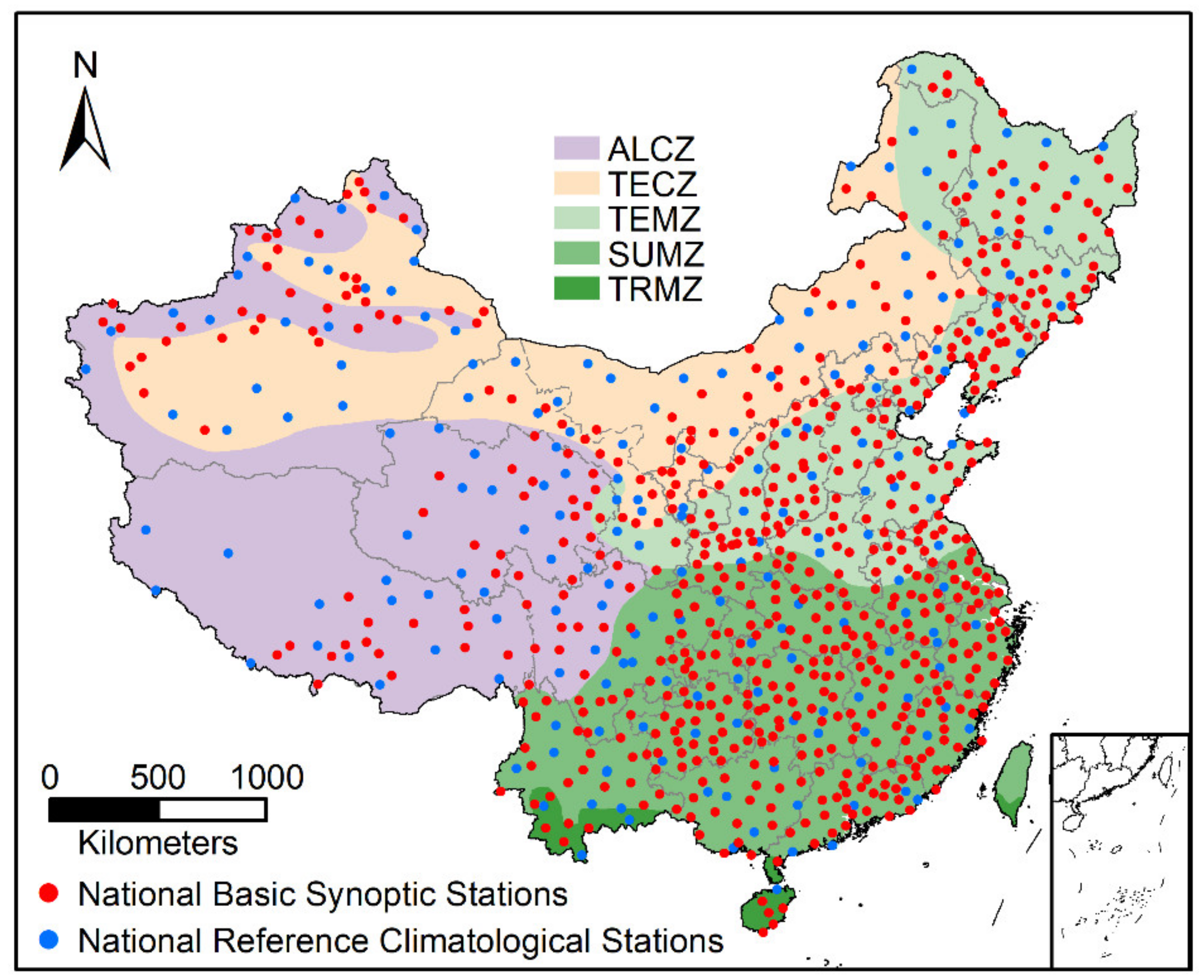
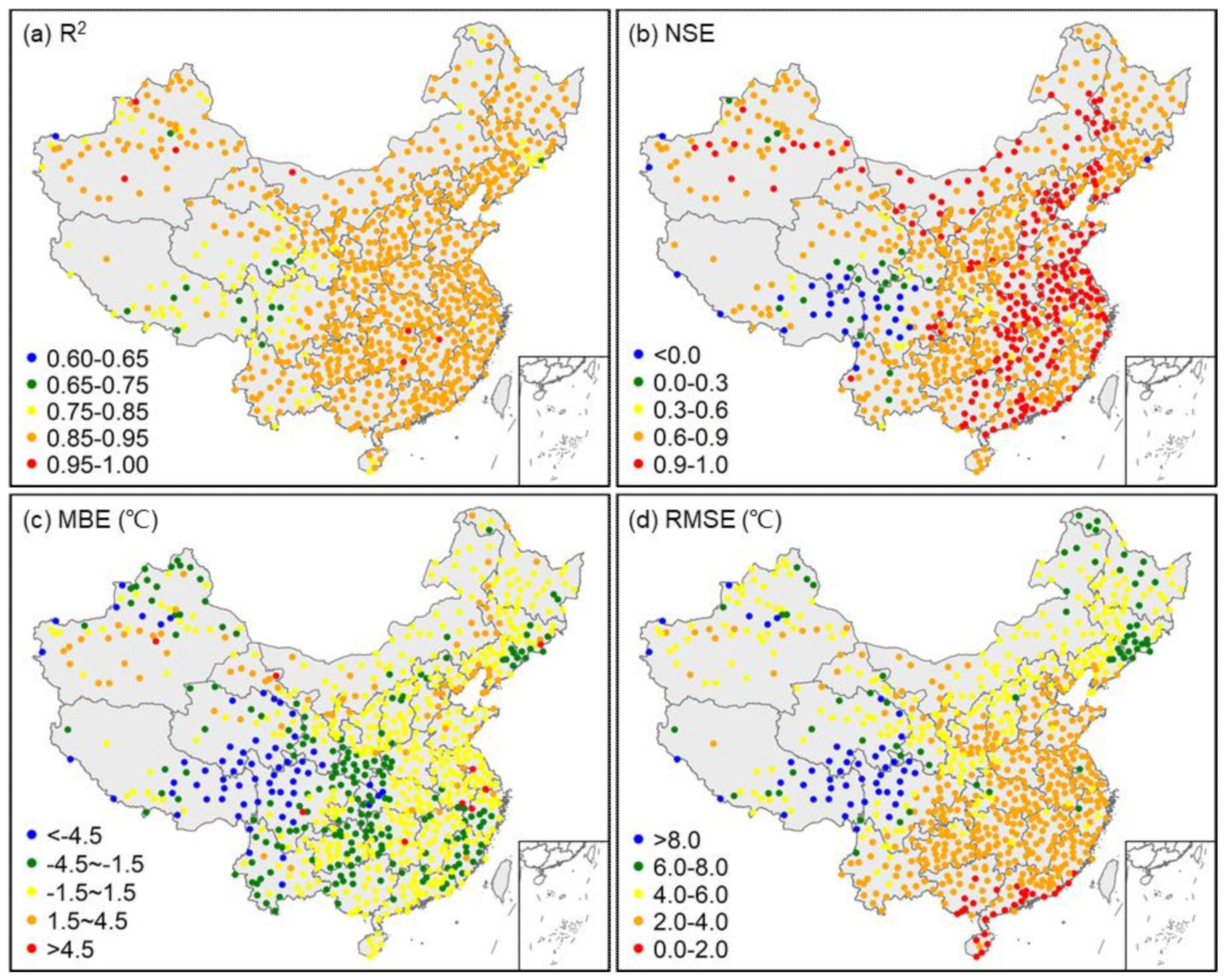
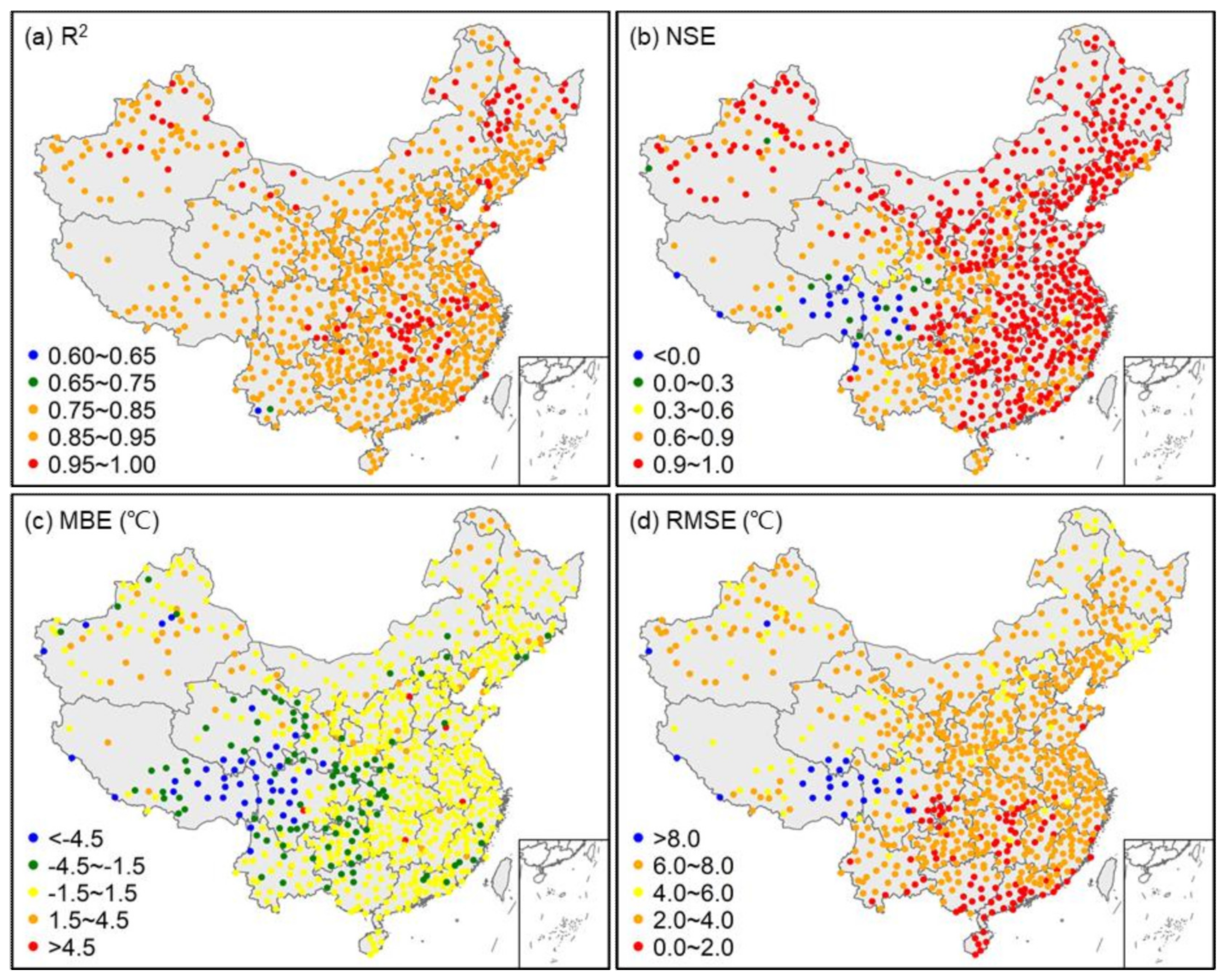
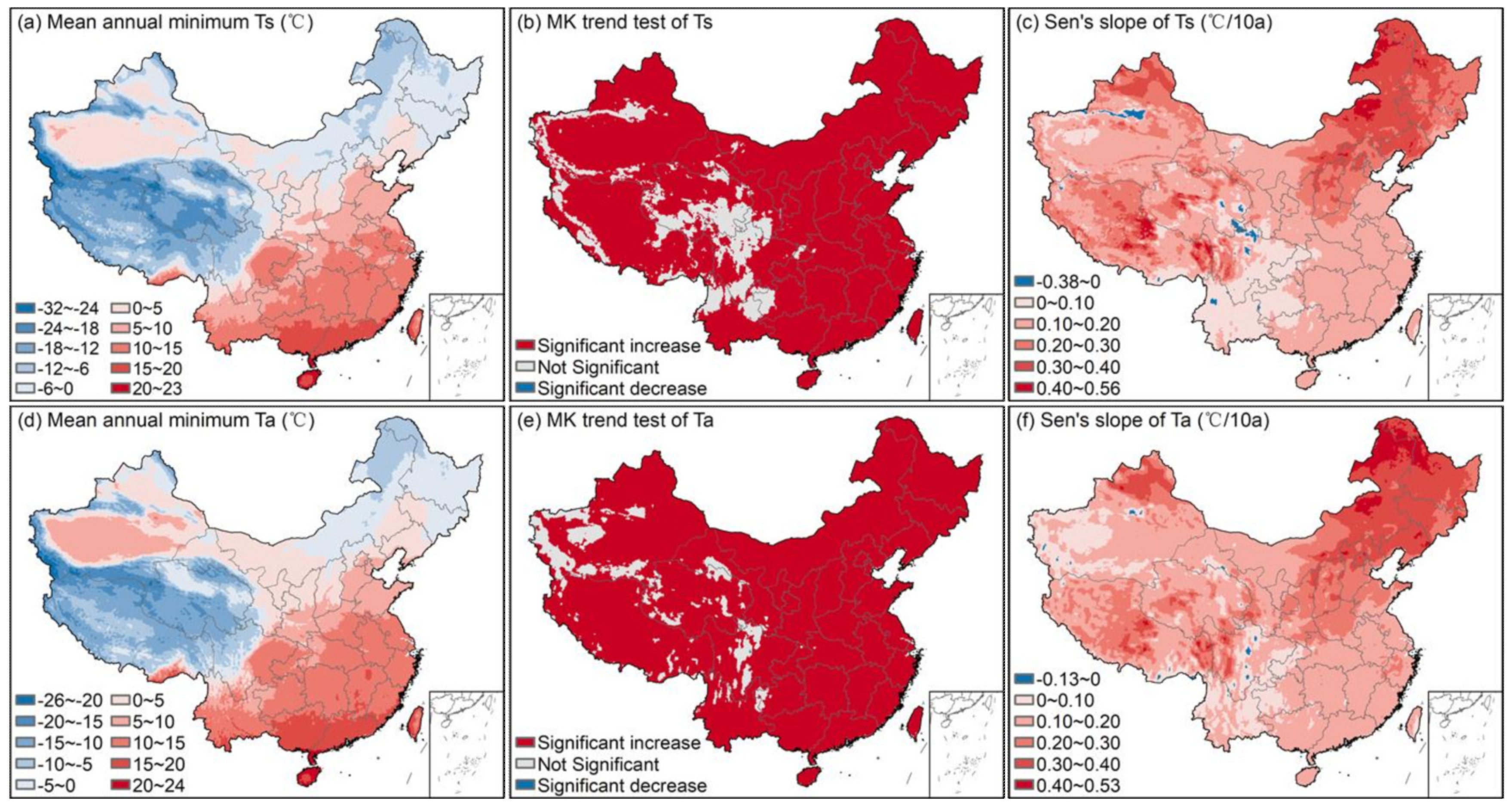
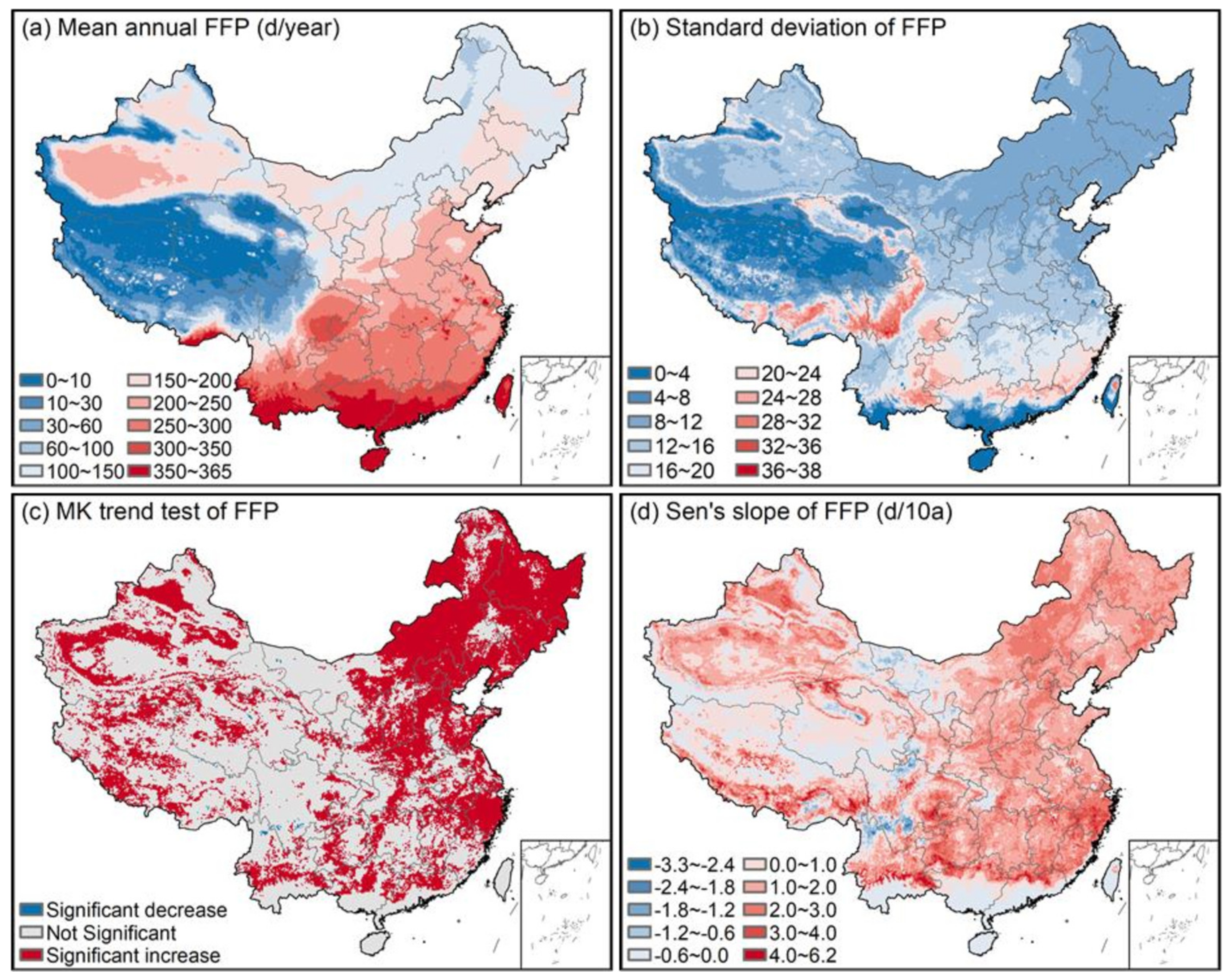



Publisher’s Note: MDPI stays neutral with regard to jurisdictional claims in published maps and institutional affiliations. |
© 2022 by the authors. Licensee MDPI, Basel, Switzerland. This article is an open access article distributed under the terms and conditions of the Creative Commons Attribution (CC BY) license (https://creativecommons.org/licenses/by/4.0/).
Share and Cite
Li, H.; Liu, G.; Han, C.; Yang, Y.; Chen, R. Quantifying the Trends and Variations in the Frost-Free Period and the Number of Frost Days across China under Climate Change Using ERA5-Land Reanalysis Dataset. Remote Sens. 2022, 14, 2400. https://doi.org/10.3390/rs14102400
Li H, Liu G, Han C, Yang Y, Chen R. Quantifying the Trends and Variations in the Frost-Free Period and the Number of Frost Days across China under Climate Change Using ERA5-Land Reanalysis Dataset. Remote Sensing. 2022; 14(10):2400. https://doi.org/10.3390/rs14102400
Chicago/Turabian StyleLi, Hongyuan, Guohua Liu, Chuntan Han, Yong Yang, and Rensheng Chen. 2022. "Quantifying the Trends and Variations in the Frost-Free Period and the Number of Frost Days across China under Climate Change Using ERA5-Land Reanalysis Dataset" Remote Sensing 14, no. 10: 2400. https://doi.org/10.3390/rs14102400
APA StyleLi, H., Liu, G., Han, C., Yang, Y., & Chen, R. (2022). Quantifying the Trends and Variations in the Frost-Free Period and the Number of Frost Days across China under Climate Change Using ERA5-Land Reanalysis Dataset. Remote Sensing, 14(10), 2400. https://doi.org/10.3390/rs14102400





